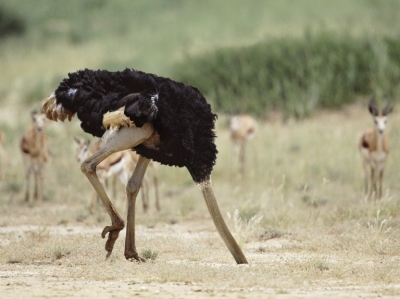
No, when danger threatens, an ostrich may run away, often at 80.5km (50 miles) an hour. But it can also inflict terrible wounds by kicking out with its powerful legs and sharp toes.
Ostriches are the largest and heaviest living birds in the world. Despite standing seven to nine feet tall and weighing as much as 350 pounds, these birds have relatively small heads. When nesting, they dig shallow holes in the ground to use as nests for their eggs. They use their beaks to turn their eggs several times each day. From a distance, an ostrich leaning into a hole to turn an egg could easily look like it’s burying its head in the sand!
This myth could also have arisen from a couple of other ostrich behaviors. For example, when ostriches eat plants along the ground, they could easily look like they’ve buried their heads in the sand, especially from a distance. Likewise, ostriches often lie down flat on the ground when they feel threatened. From a distance, all that’s visible is their large body, leading some to think that the rest may be buried.
Even though they get a bad rap, ostriches are very interesting birds. Native to Africa, they tend to roam savanna and desert areas, grazing on plants alongside giraffes and zebras. The ostrich was once known as the “camel bird,” because of its long neck, large eyes, long eyelashes, and unique walk. Like camels, ostriches can also tolerate high temperatures and go without water for days.
Even though they’re birds, ostriches cannot fly. Their bodies are simply too large to permit flight. They can, however, run like the wind! Their long, powerful legs can maintain a steady speed of over 30 miles per hour, with short bursts of up to 43 miles per hour. Their wings, while useless for flight, do help them to keep their balance when they run.
Credit : Wonderopolis
Picture Credit : Google




